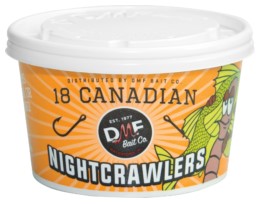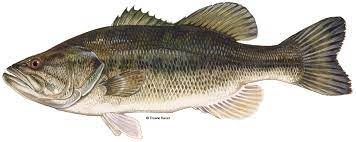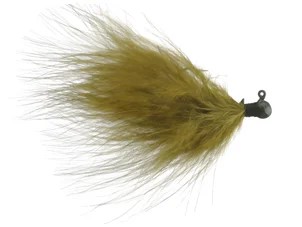One of the best species out there that can bring an incredible fight, and even a tasty meal, is the catfish. Although often overlooked by the bass fishing space and others, catfishing can be super fun and create lifelong memories.
We will be breaking down the best baits for catfish. So, whether you are a new angler, or just want to learn more about catfish presentations, this is for you.
Knowing what the best options are will put you in a spot for success. Here are the best baits for catfish!
Nightcrawlers

Night crawlers and worms are affordable and easy to find, making them a great live bait for catfish. (photo credit: DMF Bait)
When it comes to catfish bait, it doesn’t get any more traditional than worms and nightcrawlers. These baits can be super effective in many circumstances.
The first reason why nightcrawlers are a great option for catfishing is that they are easily accessible. Nightcrawlers can be bought at any bait shop and can also often be found at many gas stations that are near fishing locations.
You can even dig them up in the backyard if you want.
-

N1 Outdoors® Fishscape™ Outdoor Tee
Price range: $28.99 through $32.99 Select options This product has multiple variants. The options may be chosen on the product page -

N1 Outdoors® Word Cloud Tee (Heather Orange)
Price range: $22.99 through $28.99 Select options This product has multiple variants. The options may be chosen on the product page -
Sale!

Put A Hand N1™ Catfish Noodling Tee (various colors)
Price range: $5.00 through $9.00 Select options This product has multiple variants. The options may be chosen on the product page
So, having affordable and easy access to worms and nightcrawlers is a big reason to use them.
The other reason is that they work, plain and simple.
Nightcrawlers are awesome baits because catfish love munching on them. The scent and action of a nightcrawler is unmatched in the catfishing world.
Chicken Liver

Chicken livers for catfishing can be easily found at most grocery stores… and catfish love them! (photo credit: Walmart listing)
One really unique catfish bait is chicken liver.
Chicken livers have a very strong scent that does a great job of enticing bites from big catfish. These can be bought in bait shops and grocery stores, so you shouldn’t struggle too much to find them.
Amongst a sect of catfish anglers, this is the only bait they will use. This is a strategy that anglers fall in love with when they can find some success with it.
The key is keeping the livers cold and fresh for as long as possible. This is easy with a cooler, and as long as you replace the chunks often, you’ll be set up for success.
Stink Bait

If it stinks to you, chances are, catfish will love it… which is exactly the case with stink bait. (photo credit: Smokey’s Listing)
Catfish find food with their sense of smell. So, when you use something like stink bait, there is a good chance that you can get hooked up with a trophy. Stink bait is usually man-made and can be bought in a bait shop or made yourself.
The key attribute to stink bait is the smell, as the name implies. It is infused with natural scents that will grab a catfish’s attention. Although it is not an enjoyable smell to humans, it does a really good job in the water.
Stink bait is pretty affordable and reliable. And, because you can just go pick some up at the store, the convenience is there. If you want to get creative and save money in the long run, you can learn to make your own at home.
Bluegill

Bluegill can be a great live bait option for catching catfish, as long as it’s legal to use them in your area. Be sure to check your local fish and game regulations. (photo credit: Ohio DNR)
Although live bait is not a preferable catfishing method in many cases as it is with bass, bluegill can and do get eaten by catfish. Especially with blue cats and large channel cats, they will eat bluegill, as long as it is affixed the correct way.
In some areas, hanging trotlines is legal and very popular. Trotlines are fixtures of rope or line that have hooks and bait on them. So, it is a way to passively fish.
Where it is legal, bluegill are fantastic bait options as they will still be alive and can be a good snack for a hungry catfish.
If you cannot use trotlines, bluegill can still be a good option. The key is to either hook them through the mouth or right behind the back fin to let them move around in a natural way. This keeps the presentation as real as it gets.
Shad

Whether live or frozen, shad can be used for bait to catch catfish. (photo credit: Game and Fish Magazine)
Shad and minnows are two baits that can bring some huge bites. Whether they be alive or frozen, shad can be an especially interesting bait. Especially with big catfish in big water bodies, shad can be a majority of that fish’s diet. The key to using shad is targeting an area where they are found naturally.
If you can find an area where shad are naturally swimming around, this is an obvious choice for bait. If you want a more lively approach, you may be able to buy live shad. But, if buying live shad is not an option, you can buy packaged or frozen shad at bait shops.

Patience when catfishing can pay off BIG time!
Tips for catfishing
- Take your bait selection seriously
All of the above bait options can yield some great results on the water. So, you should really take your selection seriously. This means “matching the hatch” and doing research about specific waterways. (by “matching the hatch”. we mean using baits that resemble what the fish in the area are already naturally feeding on), When you can zero in on baits that are native to the fish’s body of water and time of year, the bites will increase.
- Bring more than enough bait
A popular way to catch catfish is sitting out all night and trying your luck. If you are going to play the waiting game and fish for longer periods of time, you should bring extra bait. The more bait the better. The thing you want is to get into a mess of fish and not have enough bait to keep catching them! Better to bring too much than too little.
- Patience is a virtue
Unlike other freshwater fishing, casting and being active with the approach is not always the best way to fish for catfish. Try casting your rig and waiting for a bite to happen rather than constantly moving around and recasting. The more patient you can be, the better. This increases the chances of you catching a monster.
Closing Thoughts On Best Baits For Catfish
Fishing for catfish can be a great way to feel the power of a big cat. And, although some anglers look down on catfish, they are tons of fun to catch, put up a great fight and can taste really good.
So, give these bait options a shot. Each one excels in certain situations, so toying and experimenting with your presentation is part of the fun. Good luck, and happy catfishing!













































